Why Mortuary Dead Body Chamber Doors Are Critical for Funeral Home Operations
Mortuary dead body chamber doors are specialized refrigeration unit doors designed to provide secure, hygienic access to individual body storage compartments while maintaining precise temperature control and preventing odor leakage. These doors serve as the primary barrier between the deceased and the external environment, ensuring dignified preservation during the time between death and final services.
Key features of mortuary dead body chamber doors include:
- Temperature control: Maintain 2°C to 8°C for refrigeration or -10°C to -20°C for freezing
- Materials: 304-grade stainless steel construction with high-density polyurethane insulation
- Sealing: Magnetic gaskets and anti-condensation systems prevent odor escape
- Security: Keyed locks and spring latches protect chain of custody
- Dimensions: Standard 68 × 50 cm individual hatches with 80 mm insulation thickness
- Safety features: Emergency releases, temperature alarms, and heated door jambs
As few people have seen a mortuary in person, the reality is quite different from TV portrayals. Modern mortuary chambers require strict temperature control between 1°C and 5°C, with bodies stored on specialized trays that lock into place for safety. The doors must maintain this critical temperature while providing easy access for funeral home staff.
I'm Mortuary Cooler, a national-level mortuary cooler supplier with extensive experience helping funeral homes select the right mortuary dead body chamber doors for their specific needs. My background includes working with funeral directors across the country to customize door configurations, materials, and features that meet both operational requirements and budget constraints.
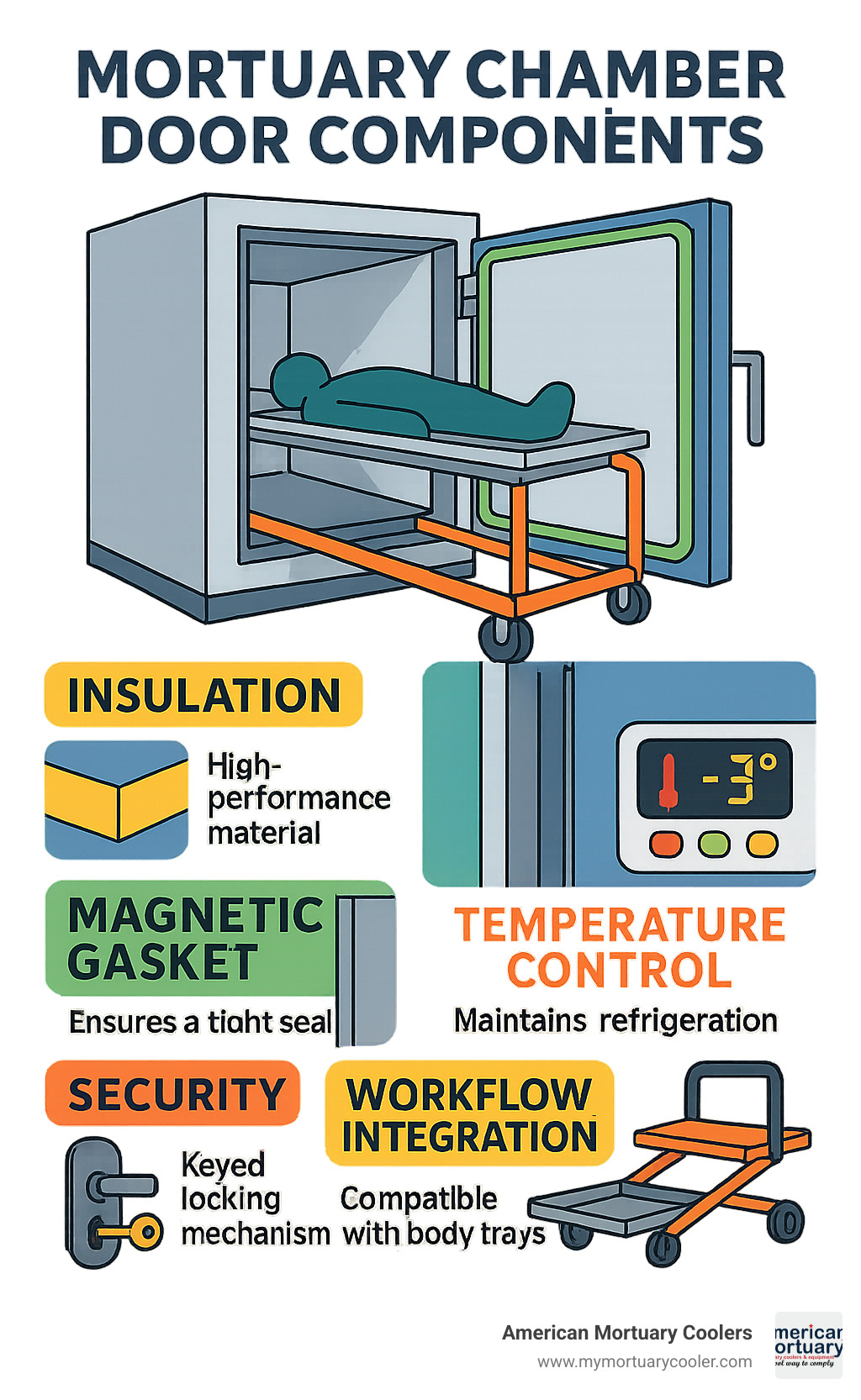
What Are Mortuary Dead Body Chamber Doors?
Mortuary dead body chamber doors are specialized access points that protect individual refrigerated compartments within mortuary cooling systems, creating a secure barrier between the deceased and the outside world.
These doors maintain exact temperatures needed for proper preservation while funeral homes coordinate services with families. Each door protects its own cadaver compartment, operating within carefully controlled temperature zones that range from 2°C to 8°C for standard refrigeration, or -10°C to -20°C when freezer storage is required.
These doors support the legal chain-of-custody requirements that funeral homes must follow. Every time a door opens or closes, it's part of a documented process that ensures the right person is being cared for properly.
For more information about how these doors fit into mortuary operations, our guide Morgue Doors Explained: What's Behind Door Number One? walks through the entire system.
Core Components of Mortuary Dead Body Chamber Doors
Every mortuary dead body chamber door is built from five critical components that work together to create an effective protective barrier.
The door leaf forms the main panel you see and touch when opening a compartment. These are built from 304-grade stainless steel because it stands up to constant cleaning and disinfection without corroding or staining.
The frame provides the structural foundation that keeps everything aligned properly. Modern frames include thermal breaks that prevent condensation from forming where warm air meets cold surfaces.
The hinges are precision-engineered components that handle hundreds of opening cycles while keeping the door perfectly aligned. Quality hinges come pre-lubricated and are rated for thousands of operations.
The gasket prevents odor leakage and maintains temperature integrity. Most systems use magnetic-core gaskets that automatically pull the door into proper sealing position when closed.
Finally, the insulation layer consists of high-density polyurethane foam injected between the inner and outer door panels, creating the thermal barrier that makes temperature control possible.
Standard Dimensions & Thickness
Industry-standard mortuary dead body chamber doors typically measure 68 x 50 cm for individual hatches, though dimensions can be customized based on each facility's needs. Door panels range from 4-inch to 10-cm thick construction, with 80mm PUF insulation being the most popular specification.
For funeral homes serving diverse communities, bariatric widths of 80cm or 95cm accommodate larger individuals with dignity. Walk-in mortuary systems feature full-height doors ranging from 36" x 76" up to oversized entrance doors for maximum accessibility.
Engineering Design & Hygiene Advantages
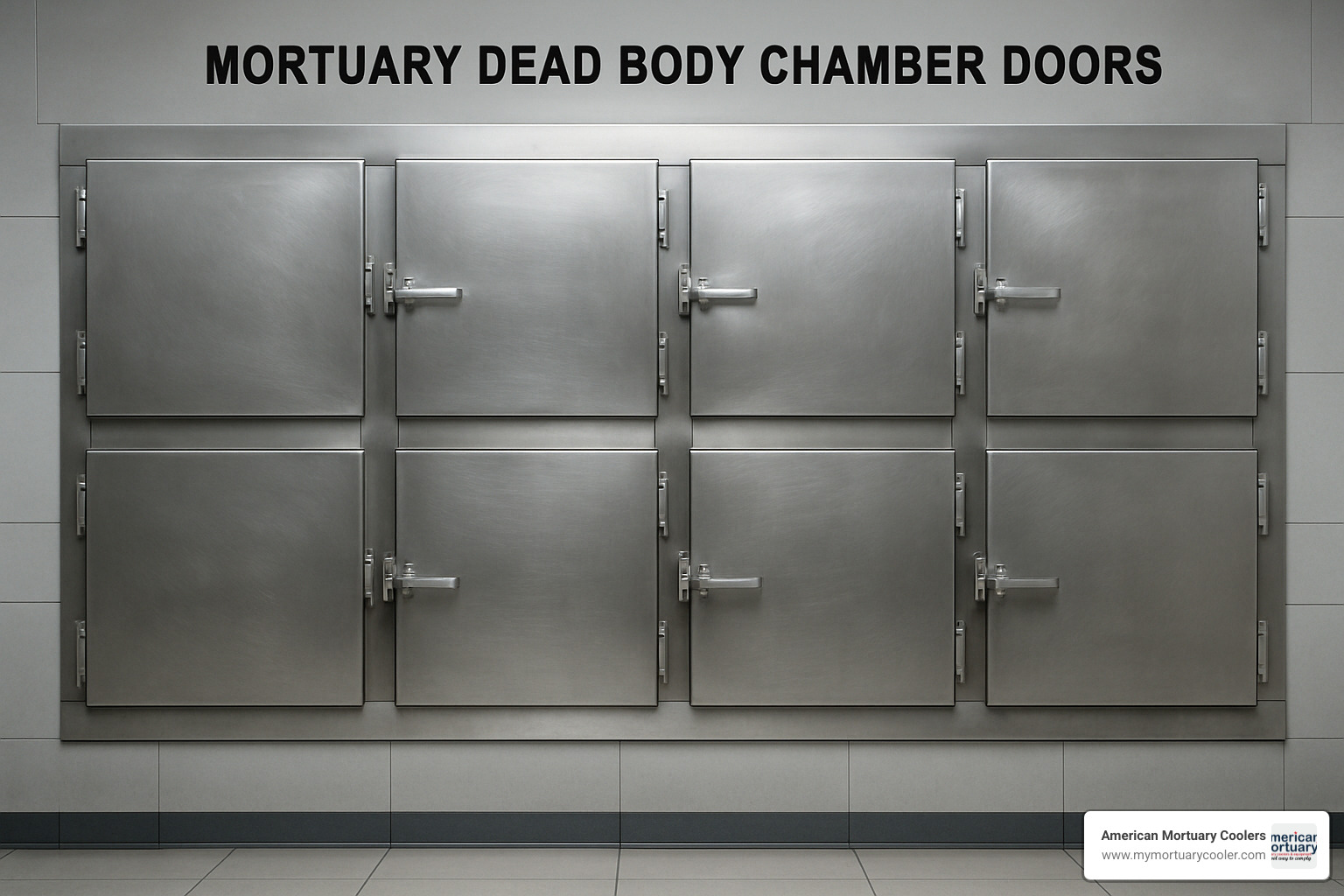
The engineering behind mortuary dead body chamber doors creates a system that respects both the deceased and the people who care for them.
Stainless steel 304 forms the backbone of quality mortuary doors. This medical-grade material resists corrosion and handles daily cleaning without breaking down. For funeral homes with tighter budgets, plastic-coated steel offers adequate protection and easier cleaning than basic materials.
The real innovation happens with foamed-in polyurethane insulation. This is injected as a liquid that expands to fill every gap, creating a seamless thermal barrier. Combined with antimicrobial gaskets, this creates an environment where bacteria can't establish a foothold.
Rounded corners eliminate hiding spots for contaminants. When everything flows smoothly, cleaning becomes thorough and efficient.
Insulation & Temperature Control
High-density PUF insulation keeps temperatures stable while keeping energy costs reasonable. Freezer doors and refrigerator doors need different engineering approaches based on their temperature requirements.
| Temperature Range | Insulation Thickness | R-Value | Energy Load |
|---|---|---|---|
| +2°C to +8°C | 80mm | R-28 | Low |
| -10°C to -20°C | 100mm | R-35 | High |
Seal Integrity & Odor Prevention
Magnetic gaskets automatically pull doors into perfect alignment every time. These have magnetic cores that create consistent sealing pressure around the entire door perimeter.
Heated jambs prevent ice buildup in freezer applications, while dual sweeps provide backup protection at critical sealing points. The odorless rubber compounds used in modern gaskets ensure that sealing materials don't contribute to odor concerns.
Surface Finishes & Cleanability
Flush surfaces and seamless welds make cleaning routines actually effective. When there are no cracks or crevices for contaminants to hide, a quick wipe-down gets everything clean.
Modern mortuary dead body chamber doors work with CIP detergents - industrial-strength cleaning systems used in hospitals. Quick-swap gaskets mean you can replace seals when needed without calling a technician.
Security, Safety & Compliance Features

Security features in mortuary dead body chamber doors serve three main purposes: protecting the chain of custody, preventing unauthorized access, and ensuring compliance with legal requirements.
Most funeral homes use keyed cam locks because they're reliable and straightforward. For facilities needing extra protection, pad-lock hasps add another visible security layer. The newest facilities use NFC access systems that create digital records of every door opening.
Locking Mechanisms on Mortuary Dead Body Chamber Doors
Keyed latch systems remain the gold standard, built with brass or stainless steel components that handle moisture and cleaning chemicals. Keypad systems are becoming popular because they eliminate lost key problems and can store audit trails showing exactly when each compartment was accessed.
For maximum security facilities, biometric or card-access systems ensure only authorized personnel can access specific compartments, providing full digital certification of every access event.
Emergency Releases, Alarms & Condensation Control
Glow-in-the-dark emergency releases function even during power outages and are positioned for easy access. Door-open buzzers alert staff when compartments are left unsealed, preventing temperature loss.
High and low temperature alarms notify operators when system performance falls outside acceptable ranges. Anti-fog resistors prevent condensation buildup on door surfaces.
For comprehensive information about how these systems work together, visit The Essential Guide to Morgue Coolers: Understanding Options and Manufacturers.
Regulatory Standards & Certifications
OSHA requirements focus on worker safety. UL-NSF certifications guarantee electrical and sanitary safety standards are met. EISA Title III regulations mandate energy efficiency standards that help reduce operating costs.
CE-ISO 9001 certifications demonstrate quality management compliance, while local health codes address temperature monitoring, access controls, and hygiene protocols.
For real-world insights into mortuary operations, this external research on morgue temperatures provides valuable perspective from industry professionals.
Door Configurations & Workflow Efficiency
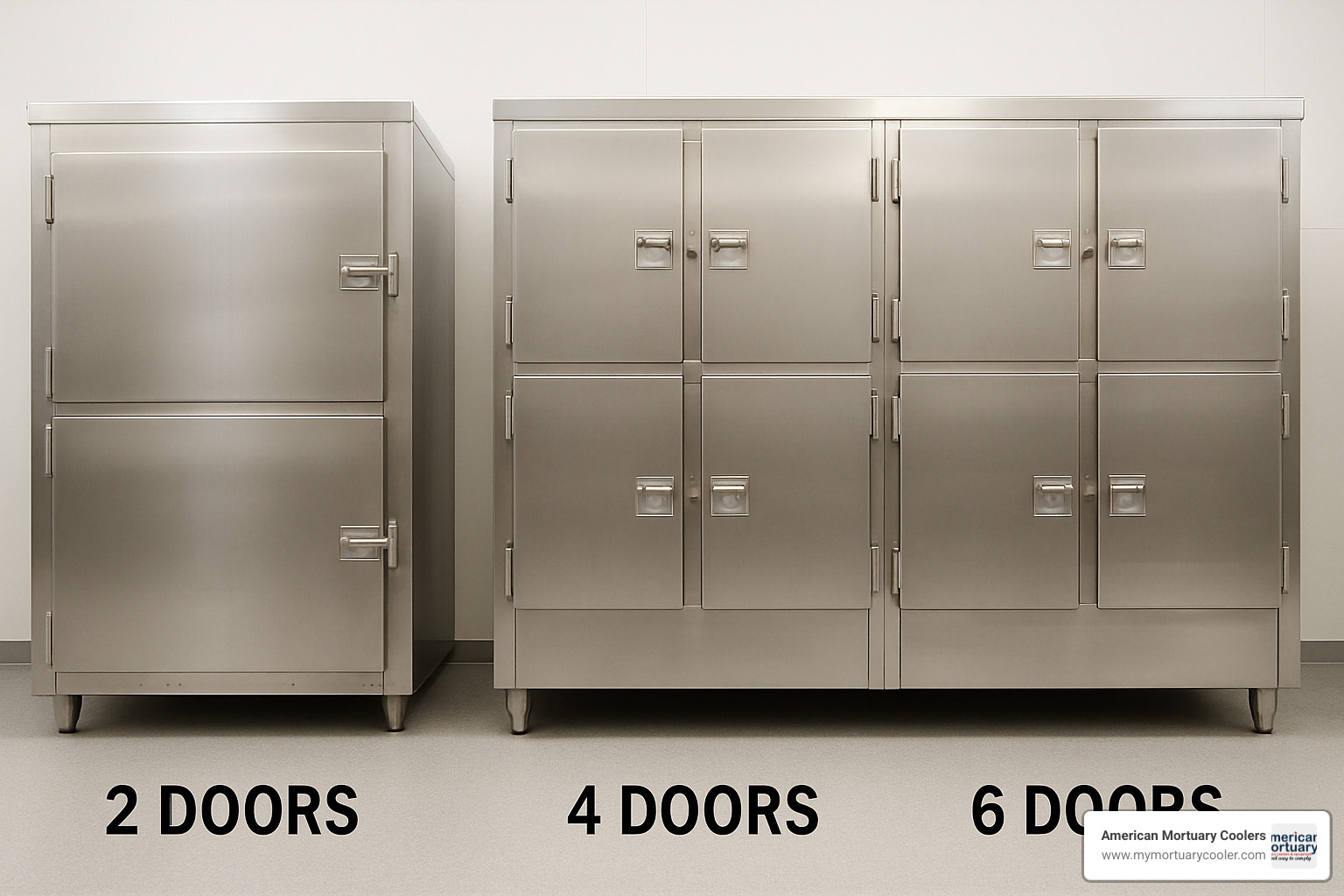
Choosing the right door configuration for your mortuary dead body chamber doors makes the difference between smooth operations and workflow headaches. Common configurations range from compact 2-door units for smaller funeral homes to expansive 6-door systems for high-volume operations.
Individual hatch systems provide the gold standard for security and temperature control. Each compartment gets its own dedicated door, so opening one doesn't affect the others.
Pass-through doors create seamless workflow between preparation areas and storage spaces, reducing handling time and improving efficiency.
Types of Mortuary Dead Body Chamber Doors
Individual hatch doors remain most popular because they offer maximum flexibility. Each compartment operates independently with separate locking.
Full-height swing doors serve walk-in mortuary systems, typically measuring 36" x 76" or larger with heavy-duty hinges designed for thousands of opening cycles.
Slide-up hatch doors solve space problems in facilities with low ceilings, sliding upward instead of swinging out.
Bariatric doors accommodate larger individuals with wider openings and reinforced construction, extending to 80cm or 95cm width.
Loading, Unloading & Ergonomics
Roller tray systems integrated with doors eliminate back-breaking lifting work. Cadaver lifts work with telescopic door systems to make transfers effortless.
Tray indexing systems ensure bodies position correctly within compartments every time, with door-integrated guides that align trolleys and transfer equipment.
Energy Efficiency & Operational Cost Impact
Zoned cooling systems with smart doors can reduce energy bills by 30-40%. Instead of cooling every compartment continuously, these systems only cool occupied spaces.
Door cycle analysis reveals that frequent opening dramatically impacts energy consumption. Well-designed doors with excellent insulation minimize heat gain during access periods.
For comprehensive information about efficiency features, check out our guide on mortuary cooler options and features.
Maintenance, Customization & Lifecycle Management
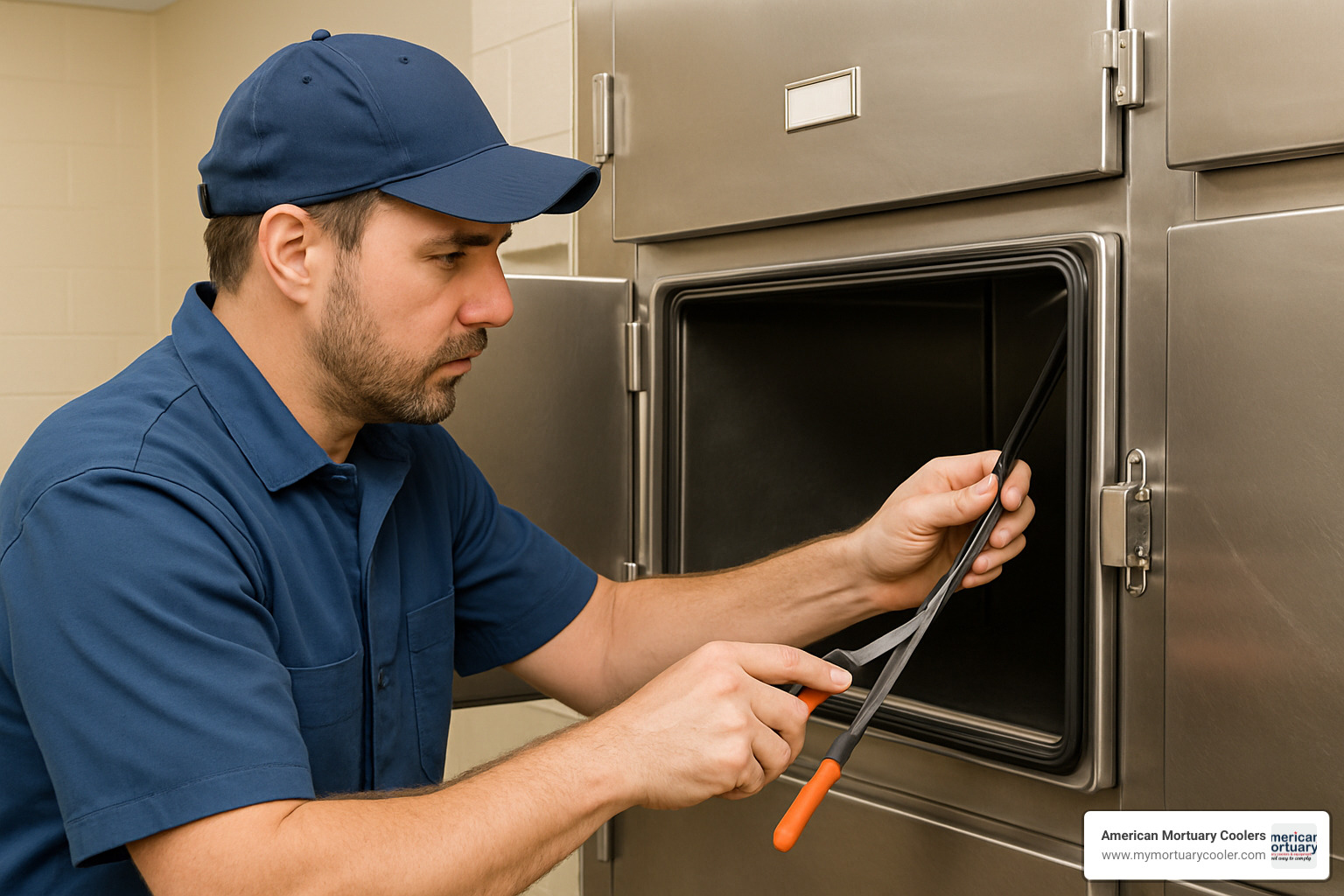
Proper maintenance of mortuary dead body chamber doors ensures reliable operation and extends equipment life. Weekly cleaning protocols, monthly compressor checks, and annual comprehensive inspections form the foundation of effective maintenance programs.
Routine Maintenance Checklist for Mortuary Dead Body Chamber Doors
Weekly Tasks:
- Sanitize all door surfaces with approved disinfectants
- Inspect gasket seals for damage or wear
- Test door alignment and closing mechanisms
- Verify temperature readings match set points
Monthly Tasks:
- Test alarm systems and emergency releases
- Lubricate hinges and moving parts
- Check door lock operation
- Inspect electrical connections
Annual Tasks:
- Comprehensive gasket replacement
- Calibrate temperature control systems
- Professional refrigeration system service
- Update maintenance logs and compliance records
Customization Options & Upgrades
Mortuary dead body chamber doors can be customized with varying numbers of doors per unit, different finish materials, and specialized features like heated glass view panels.
Branding plates allow funeral homes to customize door appearance with company logos. Interior lighting can be upgraded to LED fixtures with motion activation, while advanced temperature monitoring provides remote alerts.
For comprehensive door selection guidance, review our guide on Doorway to Preservation: Selecting Mortuary Dead Body Storage Freezer Doors.
Lifecycle Cost & Warranty Considerations
Energy audits help funeral homes understand long-term operational costs. Doors with superior insulation may cost more initially but provide significant energy savings over their lifespan.
Industry-standard warranties typically include 10-year coverage on panels and insulation, with 1-year standard compressor warranties. Extended 4-year compressor exchange programs provide additional protection.
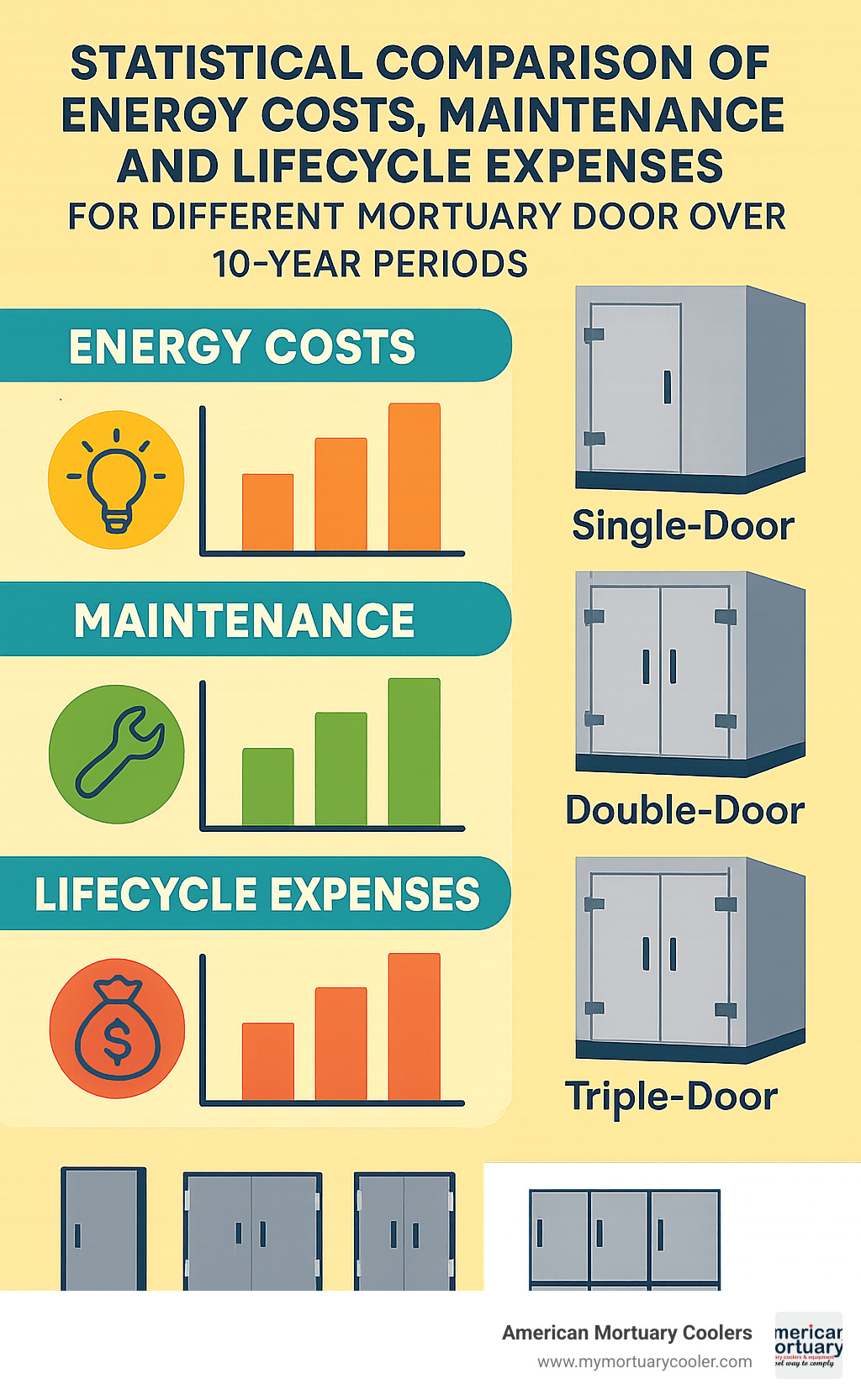
Frequently Asked Questions about Mortuary Dead Body Chamber Doors
How do these doors stop odor leakage?
The battle against odor leakage is won through a carefully engineered multi-layer defense system built into every quality mortuary dead body chamber door. Magnetic gaskets form the first line of defense, creating consistent pressure that automatically adjusts around the entire door perimeter - think of them as a flexible seal that never loses its grip.
What makes these gaskets special is their odorless rubber compounds. Unlike standard rubber seals, these materials are specifically formulated to remain odor-neutral, so they never contribute to unwanted smells themselves. The vapor barrier properties work at the molecular level, preventing odor molecules from migrating through door materials even over extended periods.
The final piece of the puzzle is proper door alignment. When a door closes correctly, these sealing systems work together to create an airtight barrier that keeps everything contained where it should be. It's like having multiple locks on your front door - each one adds another layer of security.
What emergency features protect staff inside the chamber?
Safety always comes first in mortuary design, and walk-in mortuary systems include several critical features to protect staff. The most important is the glow-in-the-dark emergency release - these releases function even during power outages and are positioned at standard height with clear markings so anyone can find them quickly, even in complete darkness.
Door-open alarms serve as a buddy system, alerting other staff when someone is working inside the chamber. This ensures that no one is forgotten or left alone in an emergency situation. Many modern systems also include communication systems that allow direct contact with external personnel if assistance is needed.
These safety features aren't just good practice - they're often required by local safety codes and OSHA regulations to protect funeral home workers.
Are freezer doors different from refrigerator doors?
Absolutely, and the differences are more significant than you might expect. Freezer mortuary dead body chamber doors face much harsher conditions than their refrigerator counterparts, so they need specialized features to handle the challenge.
Heated jambs are essential for freezer doors because they prevent ice buildup that could compromise the sealing system. Without these, ice would gradually build up around the door frame, making it impossible to achieve a proper seal and potentially damaging the gaskets.
The insulation requirements are also much more demanding. Freezer doors need thicker insulation to handle the greater temperature differential between the inside and outside environments. While refrigerator doors might use 80mm insulation, freezer doors often require 100mm or more.
Specialized gaskets designed to remain flexible at sub-zero temperatures are another crucial difference. Standard gaskets can become brittle and crack in freezing conditions, but freezer-rated gaskets maintain their sealing properties even at -20°C.
Finally, the locking mechanisms on freezer doors are often reinforced to handle the additional stress from temperature cycling, which can cause materials to expand and contract more dramatically than in refrigerator applications.
Conclusion
When you're in the funeral service industry, every detail matters—especially when it comes to mortuary dead body chamber doors. These essential tools help you provide dignified care while keeping your operation running smoothly and cost-effectively.
Whether you're looking at basic 68 x 50 cm individual hatches or sophisticated walk-in systems, the right doors must maintain precise temperatures, keep odors contained, provide secure access, and meet strict hygiene standards—all while being reliable for daily use.
Modern mortuary doors maintain consistent cooling, prevent unwanted smells from escaping, keep everything secure, and make cleaning efficient. Understanding the technical specs, maintenance requirements, and customization options helps you make the best choice for your facility.
At American Mortuary Coolers, we create custom mortuary cooling solutions that fit exactly what each funeral home needs. With our Tennessee headquarters and direct delivery across all 48 contiguous states, we support funeral homes wherever they are.
We've worked with funeral directors in all kinds of situations—from small-town funeral homes to busy urban facilities handling dozens of cases weekly. The right door setup makes a huge difference in daily operations, staff efficiency, and long-term operating costs.
We take time to understand your space limitations, specific needs, and budget constraints. Then we recommend door solutions that actually work for your situation.
Energy savings alone can make quality mortuary dead body chamber doors pay for themselves over time. Add in lower maintenance costs, improved staff efficiency, and the confidence that comes from providing respectful care—and the investment makes perfect sense.
For a complete look at everything we offer, including cooling systems, doors, and essential equipment, check out our comprehensive guide on Comprehensive Solutions for Mortuary Needs.
Choosing the right doors isn't just about specifications and warranties. It's about having peace of mind so you can focus on what really matters—providing comfort and dignity to families during their most difficult moments.
















